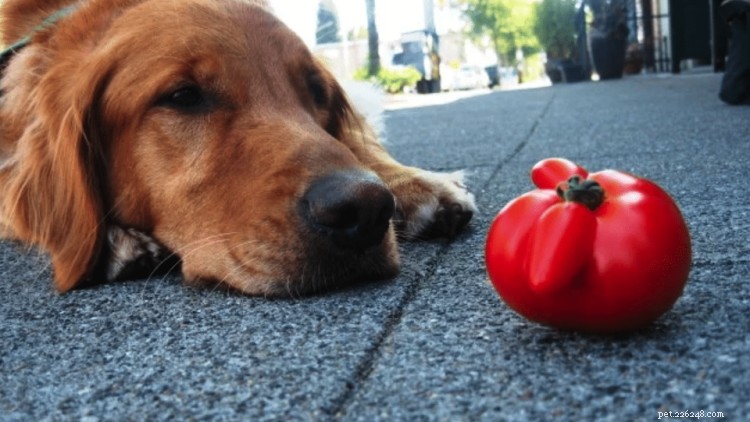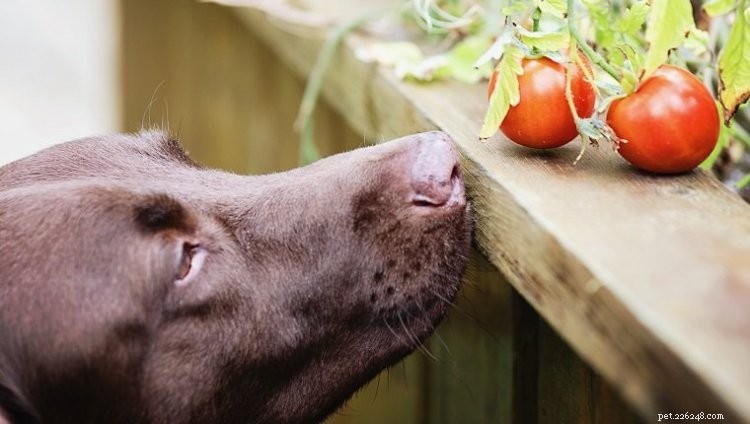Os cães podem comer tomates? Aqui está tudo o que você precisa saber
Os tomates são um dos vegetais mais saborosos para os humanos, mas nossos companheiros caninos também podem comê-los? A resposta curta é sim, os cães podem comer tomates, desde que seus donos entendam os riscos.
Os tomates pertencem à família das beladonas e algumas partes desses vegetais contêm substâncias que podem ser tóxicas para os cães se consumidas em grandes quantidades. Embora o envenenamento por tomate seja raro, pode acontecer, especialmente se o seu animal de estimação colocar as patas em tomates verdes.
Aqui está um resumo de tudo o que você precisa saber sobre cães comendo tomates.
Índice:
- Benefícios do tomate para a saúde para cães
- Os tomates são ruins para os cães?
- Os cães podem comer tomates cozidos?
- Os cães podem comer tomate cereja e uva?
- Os cães podem comer tomates enlatados?
- E os tomates secos ao sol?
- Como alimentar os cães com tomates
- Principais conclusões
Dica profissional: Cães curiosos às vezes podem engolir alimentos que podem ser perigosos. O seguro para animais de estimação pode ajudar a aliviar o fardo das contas inesperadas do veterinário de acidentes como a ingestão de veneno. A tranquilidade que vem com o seguro para animais de estimação permite que você se concentre em obter o melhor tratamento para seu animal de estimação sem ter que se preocupar com como vai pagar por isso.
Benefícios de saúde dos tomates para cães
Os tomates são muito ricos em nutrientes e oferecem muitos benefícios para a saúde dos seres humanos que os cães também podem desfrutar.
Melhor visão
Muitos problemas de visão, como cegueira noturna e catarata, resultam da falta de vitamina A na dieta. Os tomates são ricos em vitamina A e beta-caroteno, que ajudam a diminuir problemas relacionados aos olhos e retardam a degeneração macular. O betacaroteno também é um poderoso antioxidante que previne danos oxidativos e mantém um pelo e pele saudáveis.
Imunidade aprimorada
Tomates maduros contêm licopeno, um fitoquímico que lhes dá a cor vermelha característica e está principalmente concentrado na pele. Este nutriente vegetal é um poderoso antioxidante que combate os radicais livres nocivos e protege as células do sangue, coração, pulmões, nervos e músculos. Também promove ossos fortes e reduz o risco de doenças cardíacas e derrames.
Pele e pelagem saudáveis
As vitaminas C e A mantêm a pelagem e a pele saudáveis, apoiam o sistema imunológico, ajudam a promover a saúde das articulações, fortalecem os ossos e mantêm o desenvolvimento muscular adequado.
Melhoria da saúde cardiovascular
Os tomates também contêm altos níveis de potássio, um mineral conhecido por regular os níveis de colesterol e pressão arterial, estabilizar a função neural e regular o açúcar no sangue.
Os tomates também são abundantes em ferro, que desempenha um papel essencial na circulação sanguínea saudável, vitamina K, uma vitamina lipossolúvel que ajuda a coagular o sangue, bem como fibra solúvel que promove uma digestão saudável e movimentos intestinais regulares.
 (Fonte da imagem:CaesarsWay)
(Fonte da imagem:CaesarsWay) Algumas fatias de tomate cru, maduro e maduro servidas com moderação são seguras para o seu cão comer . De fato, alguns alimentos para cães incluem bagaço de tomate como ingrediente porque é uma excelente fonte de vitaminas e minerais benéficos.
Os tomates são ruins para os cães?
Os tomates pertencem à família de vegetais das beladonas (também conhecidas como Solanaceae). Eles contêm alfa-tomatina e solanina, dois compostos tóxicos que também são encontrados em outras plantas de erva-moura, como berinjela e batata verde. As maiores concentrações de solanina são encontradas nas partes verdes da planta:as folhas, caules e trepadeiras.
Tal como acontece com outros alimentos humanos, existe o risco de que seu amigo de quatro patas seja alérgico a tomates , mesmo que estejam maduros. Se você notar sinais como espirros, tosse, urticária, diarréia, gases ou erupções cutâneas com coceira, pare de alimentar seu animal de estimação com tomates e entre em contato com seu veterinário. Em casos raros, uma reação alérgica pode levar a anafilaxia, uma condição potencialmente fatal. Sinais como inchaço, urticária e dificuldade para respirar podem ser sinais de uma reação alérgica grave e devem levar você a procurar atendimento veterinário de emergência.
Alguns cães têm condições médicas , como problemas gastrointestinais e refluxo ácido, que os tomates podem piorar. É por isso que é melhor consultar seu veterinário antes de dar ao seu animal de estimação qualquer alimento humano.
The tomato itself contains high doses of solanine when it is unripe and green. As the tomato ripens, the concentrations of solanine rapidly decrease, which means that your dog can safely eat ripe tomatoes, but should stay away from green ones. If you have a tomato plant in your garden, you should be extra careful as your furry pal might eat the poisonous green parts.
Signs of Tomatine Poisoning
If a dog eats large quantities of the green parts of the tomato plant, they may experience the following symptoms:
- Vômitos
- Diarréia
- Fraqueza
- Letargia
- Loss of coordination
- Confusion
- Perda de apetite
- Hypersalivation
- Pupilas dilatadas
- Sonolência
- Abnormal heart rate
- Tremors
- Convulsões
Dica profissional: Accidental poisoning is one of the leading causes for emergency vet visits. If that happens, you’ll want to make sure your dog is covered by a solid pet insurance policy so you know they can receive the best possible care without breaking your budget.
Treatment of tomatine poisoning in dogs
If you notice any of the above-listed symptoms of tomato poisoning, take your dog to the vet right away. Your vet will assess your pet and determine if it is safe and necessary to induce vomiting. This is best done at the veterinary office so that your pet can be closely monitored.
Your vet may also recommend additional treatments, such as fluid therapy , especially if your pet has diarrhea or experiences vomiting, to help the body flush the toxins out and treat the dehydration.
As mentioned before, tomato poisoning in dogs is rare and the prognosis of a full recovery is good . The clinical signs listed above can be a sign of other serious health issues as well, so you should always contact your veterinarian if your pet is exhibiting any of these symptoms.

(Image source:DogTime)
Can dogs eat cooked tomatoes?
Store-bought cooked tomato products that contain tomatoes, like juices, soups, and sauces, might be unhealthy for your canine companion because they often contain sugar, salt, artificial flavors, and other harmful ingredients.
Avoid feeding your dog tomato sauce, especially pasta sauce. These sauces often contain ingredients that could be unhealthy for your pet such as garlic, onions, and chives.
If you want to feed your pet cooked tomatoes, it’s better to stick to fresh ones that you prepare yourself .
When it comes to ketchup, plain is okay but spicy flavors, such as sriracha and jalapeño, should be avoided. Be sure to check the ingredient list on the ketchup bottle. Some ketchup brands might contain xylitol, an artificial sweetener that can be very dangerous for your furry baby.
Can dogs eat cherry tomatoes and grape tomatoes?
There are many different varieties of tomatoes from grape to cherry, and everything in-between. But are any of these varieties more or less toxic to your pet?
The answer is no. Grape tomatoes, cherry tomatoes, beefsteak tomatoes, and other varieties are safe for dogs to consume in moderation as long as they are red and ripe, and the green parts (stems and leaves) have been removed.
Can dogs eat canned tomatoes?
Canned tomatoes are very high in sodium. In large amounts, this can lead to dehydration. It is better to feed ripe, fresh tomatoes.** **If your dog eats canned tomatoes, watch for symptoms such as increased urination, excessive thirst, fever, loss of appetite, and nausea.
What about sun-dried tomatoes?
If the sun-dried tomatoes contain other ingredients (like garlic and onion), you should avoid feeding them to your pet. If there aren’t any harmful ingredients, you can either add one or two finely chopped pieces to your dog’s food or feed them directly from the jar. However, you should take care to feed only a small amount:1-2 pieces every other day should be enough unless your vet recommends otherwise.
How to feed tomatoes to dogs
If your veterinarian says your dog can eat tomatoes, be sure to choose ripe, red ones and remove the leaves, vines, and stems.
Rinse the tomato well , especially if it’s not organic as non-organic produce is sprayed with pesticides and herbicides that can make your dog sick. Serve the tomatoes to your furry pal fresh and without any additives like salt .
If you serve your canine companion a tomato-based product like soup or sauce, check the ingredient list for ingredients that might be harmful. It’s always better to stick to fresh tomatoes that you prepare yourself.
If you have tomato plants, make sure that your pet cannot access them and eat any unripened tomatoes or green parts of the plants. If you keep a tomato plant indoors, make sure it is in a pot off of the ground. If you are growing tomato plants in your garden or yard, fence the area off.
If your dog still manages to get to the tomato plants, call your veterinarian to discuss the situation. Watch them for the above-mentioned symptoms and call the veterinarian if you have any concerns.
Principais conclusões
- Red, ripe tomatoes are okay for dogs to consume in small quantities and occasionally, but they aren’t recommended as a regular treat.
- You should never give unripened green tomatoes to your pet because they contain toxic compounds.
- If you suspect your dog has eaten unripened tomatoes or the green parts of the plant and starts to exhibit symptoms of tomato toxicity, call your vet.
- Pet insurance can help you cover the cost of your dog’s treatment and care.
- Os cães podem comer alho? Aqui está tudo o que você precisa saber
- Os cães podem comer atum? Aqui está tudo o que você precisa saber
- Os cães podem comer coco? Aqui está tudo o que você precisa saber
- Os cães podem comer espinafre? Aqui está tudo o que você precisa saber
- Os cães podem comer feijão verde? Aqui está tudo o que você precisa saber
- Os cães podem comer nozes? Aqui está tudo o que você precisa saber
- Os cães podem comer carne crua? Aqui está tudo o que você precisa saber

